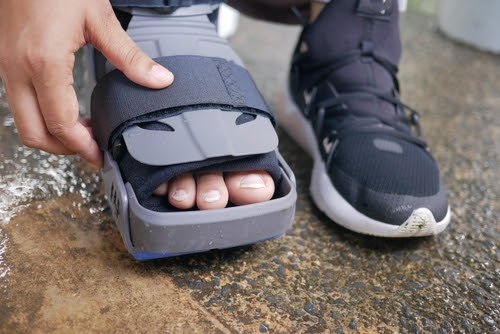Fracture in Your Foot? Four Resets Needed for Recovery that Exercise Alone Doesn’t Do
The theme for this week …
What happens with your bones directly affects the muscles. When bones are immobilized for healing, the muscles tend to go offline. This impacts your ability to be active, which is where Bridging® comes to the rescue. By resetting muscle relationships you can, once again, be active.
This month we’ll explore common bone injuries and how your muscles are affected, beginning with your feet. Read on …
Fracture your fifth or first metatarsal?
Being active for our physical, cognitive and emotional health generally involves using our feet! This also means that over the years they are likely to be injured.
Foot fractures are common with the outer long bone, known as the fifth metatarsal, being the most common. The second most injured bone aligns to the big toe, the first metatarsal.
Immobilization, oh no!
With a fracture, immobilization is generally the course of treatment ranging from a cast to a boot or a rigid shoe. Depending upon the location of the fracture, the immobilization will be for 6-12 weeks.
This lengthy immobilization is rough on the tiny muscles of the feet and ankles, as well as the interconnections to the knee and hip. The automatic coordination goes offline, and generally doesn’t reboot from exercises and stretching. You need a specific muscle reset.
Why is foot immobilization an issue?
When you injure a bone in your foot there are two aspects of recovery to address to restore long term function. These are the questions we consider when problem-solving with clients:
- Immobilization: Which muscle relationships are impaired due to the lengthy immobilization?
- Compensation: Which muscle relationships are stressed from hobbling around with uneven gait for weeks?
Immobilization allows tiny foot muscles to switch off
From the time we are infants, our feet are busy moving around, scrunching up, and pushing around.
These essential muscle interactions are well-developed and strengthened in the process. Walking and jumping around further strengthens the feet muscles and builds strong bones.
When these small muscles cannot move for a long time, they forget how to work and lose their ability to communicate with their neighboring muscles in the lower leg and knee.
Why do shut-down muscle relationships matter?
The shut-down of muscle from immobilization causes specific issues:
- Lost articulation in the mid-foot
- Lost interconnections between the foot, ankle, and knee
The good news is that these all change with the Bridging® Technique. Bridging® rebuilds the structural relationships within the foot and leg which enables strength, balance, and flexibility.
You can move again with ease and confidence!
Insight of the week from Cara
Most weeks we have someone coming to the office with a foot-related issue–sprain, pain, or balance. Often, we find that there has been a cast or boot in recent months or years. This clue leads us to look for specific relationships needing to be reset.
Gail’s fractured foot
As often can be the case, Gail had fractured a bone on her foot by a simple misstep while walking outdoors. The location of the fracture necessitated a longer period in a rigid foot brace.
Gail is normally very active as she understands its importance to her health and well-being. For many years Gail has walked 3-4 miles daily.
A year after the fracture her walking is not as smooth as it used to be. Her gait inefficiency and smoothness is a concern, and she wants to return to normal!
What four things did we find?
As you will see in the video, there were four things keeping Gail from walking smoothly. They are each easily reset by the Bridging® process:
- Ankle-Achilles coordination: The front and back of the ankle need to have an automatic reciprocal, elastic relationship. This coordination is interrupted when immobilized.
- Ankle-Knee coordination: Flexing the ankle should automatically trigger the patellar tendon (which is connected to the quadriceps/thigh muscles) coordinating movement from the foot to the knee. This reaction is also interrupted when immobilized.
- Mid-foot movement: There is a rotational movement below the ankle at the top of the metatarsals that needs to learn how to roll again. This is where your ‘spring’ comes from.
- Pelvis movement: This is a common compensation! While walking in a boot for so many weeks, she used her low back and hip to accommodate the imbalance with her feet.

